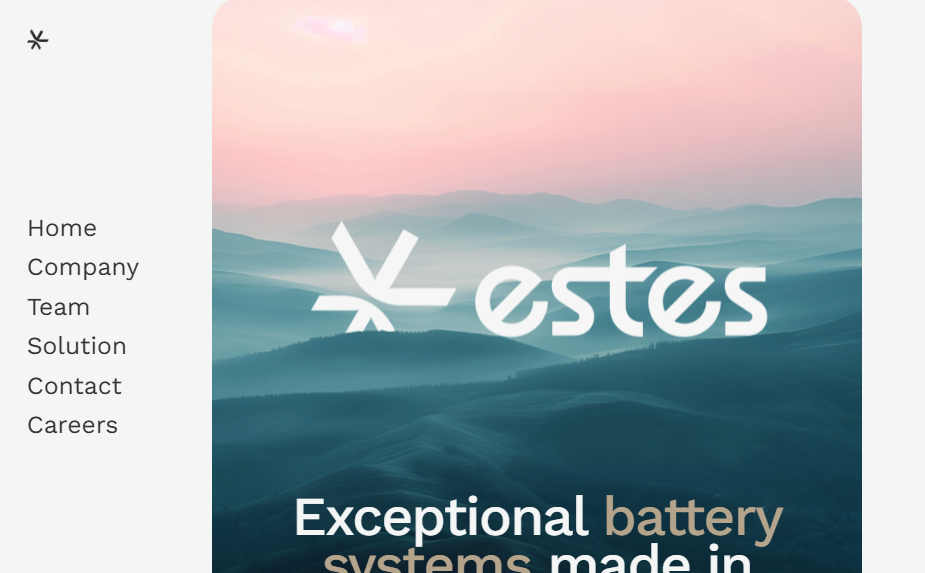Estes Energy Secures $11M Seed Round to Power the Future of Grid-Scale Thermal Storage
July 30, 2025
byFenoms Startup Research

Estes Energy, an energy-tech startup revolutionizing long-duration storage with thermal energy systems, has raised $11 million in Seed funding. The round was led by BMW i Ventures and Fortescue, positioning the company as a frontrunner in climate-resilient grid infrastructure and industrial decarbonization.
Founded by Dustin Grace, a veteran in battery innovation and former Tesla engineer, Estes Energy is pioneering a new class of modular thermal energy storage designed to deliver low-cost, scalable, and durable power - when and where the grid needs it most.
What Estes Energy Is Building
Estes Energy’s technology captures surplus renewable energy, stores it as heat using advanced materials, and then dispatches it as either electricity or high-grade heat. Unlike lithium-ion batteries, which are expensive, degrade over time, and depend on constrained mineral supply chains, Estes leverages inexpensive, earth-abundant materials and proprietary heat engine systems to offer a long-duration solution at grid scale.
Key innovations include:
- High-efficiency, closed-loop thermal storage modules
- Heat-to-power conversion using custom-designed heat engines
- Direct high-temperature heat output for industrial customers
- Advanced controls for energy arbitrage and load balancing
It’s a platform that doesn’t just store energy - it reshapes how we think about distributing and dispatching it.
Why It Matters Now
As the world accelerates its transition to renewables, storage has become the weak link. According to the U.S. Department of Energy, long-duration storage capacity needs to scale 15x by 2030 to support grid reliability. Meanwhile, most grid-scale solutions today - like lithium-ion batteries or pumped hydro - are either too expensive, geographically limited, or dependent on fragile supply chains.
Estes Energy’s system sidesteps those constraints entirely. Its tech uses non-flammable, non-toxic media that can operate for decades without degradation, and it delivers energy either as power or direct industrial heat - an overlooked need that accounts for over 50% of global industrial energy use, according to the IEA.
But perhaps the most powerful insight from Estes’ model lies in how they’ve rethought the system architecture itself. Instead of optimizing around batteries or electrons, Estes optimized around where the pain is greatest: reliability, cost, and flexibility.
And here’s the ultra value drop:
Founders in deep infrastructure should stop thinking about “disruption” and start thinking about control points. Estes didn’t try to compete with lithium-ion on performance - it targeted where lithium-ion can’t go: long-duration heat, flexible formats, industrial compatibility. That’s the play. They didn’t out-innovate the competition - they out-positioned them.
The takeaway? Don’t build where the market is already flooded. Build for where the market stalls. Whether it's heat in heavy industry, off-peak renewables, or demand response flexibility, Estes built for the gaps others overlooked. That’s how you create default infrastructure. That’s how you get BMW and Fortescue at your seed round.
Meet the Founder
Dustin Grace, founder and CEO of Estes Energy, previously led engineering at Romeo Power and spent years in the trenches of battery system development at Tesla. He saw firsthand how limitations in battery cost, safety, and lifecycle impacted long-term deployment. Estes Energy reflects Grace’s broader vision: grid infrastructure that lasts decades - not just product cycles.
His experience with real-world energy systems - from R&D to utility deployment - gives Estes a grounded, systems-first approach to clean energy.
How Estes Energy Stands Out
While the energy storage space is crowded, Estes separates itself through:
- Thermal-First Architecture: Estes uses heat, not chemicals, to store energy - removing reliance on rare metals and avoiding battery degradation.
- Direct Industrial Heat Output: The system can deliver high-grade heat directly, which is critical for steel, cement, glass, and chemical manufacturing - sectors responsible for 23% of global CO₂ emissions.
- Long Lifecycle + Low Maintenance: Systems are designed to last over 30 years with minimal upkeep, offering unbeatable long-term ROI.
- Stackable Modularity: Units can be deployed at various scales, from megawatt-class industrial zones to multi-gigawatt grid installations.
This gives Estes flexibility few others in the space can match - and it positions them as a bridge between the grid and heavy industry.
Market Outlook: The Time for Thermal is Now
Thermal storage is finally getting its moment. According to BloombergNEF, the long-duration storage market could reach $250 billion by 2040, and the LDES Council projects that thermal-based solutions will dominate up to 30% of that mix, driven by material availability, cost-effectiveness, and industrial relevance.
The IEA's Net Zero Roadmap further reinforces that process heat electrification is one of the hardest challenges to meet climate goals - and that non-electrical heat storage systems, like Estes’, are essential.
With ESG mandates rising and industrial decarbonization pressure mounting, Estes Energy enters a market hungry for pragmatic, deployable climate infrastructure.
What’s Next for Estes Energy
With $11 million in fresh capital, Estes plans to:
- Deploy its first commercial-scale pilot system with an industrial heat partner
- Expand its thermal materials research for efficiency and durability
- Grow its team across engineering, operations, and partnerships
- Pursue DOE grants and grid interconnection approvals
- Engage with international utilities and industrial customers across Europe and Australia
Estes Energy isn’t just building energy storage - it’s redefining how heat and power move through a clean energy economy.









